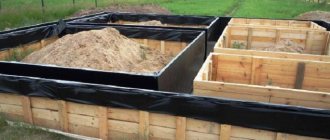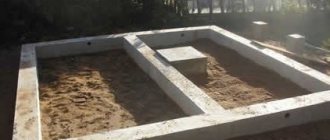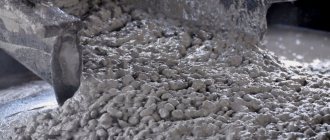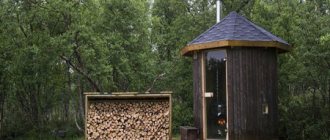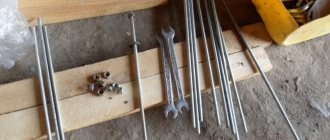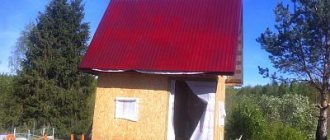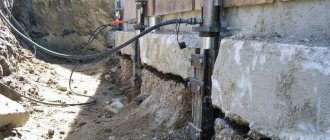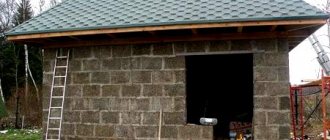When building a bathhouse, the main thing is to build the structure on a reliable foundation. To do this, you will need concrete that has two properties: strength and water resistance. Some people prefer to order concrete for the foundation of a bathhouse from construction companies, but you can make it yourself. Next, we will talk about concrete - which one is best suited, as well as the composition of the solution for these purposes.
Quality and composition of concrete
The grade of concrete is a determining indicator of its qualities. The usual marking for the construction market is the letter “M” and numbers that indicate the tensile strength of the material in kg/cm2.
In residential construction, concrete grades from M150 to M350 are used for pouring foundations. For their production, cement M400 and M500 is used in various proportions with solid fillers and water. The brand and strength of the final product depends on the quantity and quality of cement.
The content of impurities in cement should not exceed 20%. The special marking of cement, designated by the letter “D,” indicates the percentage of impurities in it.
The following solid fillers are used: sand, crushed stone, gravel or an enriched sand-gravel mixture. The finished solution should contain gravel grains of various sizes. Fine gravel fills the voids between large fractions and provides the design strength of the material.
Calculating the correct amount of concrete
Whether the owner decides to buy ready-made concrete or works to create it himself, excess building material is wasted money. The shortage should also be obviously excluded, since the structure must be filled without interruptions and without the appearance of a hardened “crust” on the surface. Therefore, it is advisable not to neglect the exact calculation of the concrete required for the construction of the foundation, for which:
- We recall the school geometry course and systematically calculate the volume of the slab, individual strips of tape with subsequent addition, pillars poured into formwork with a rectangular or square cross-section. We calculate the volume of concrete for bored piles by the internal diameter of the pipe! We multiply the squared radius by the height of the pipe and by 3.14, then multiply by the number of pieces.
- We multiply the resulting figure by the amount of concrete shrinkage. This coefficient must be indicated in the passport for the mixture purchased at the factory. It is too difficult to calculate it yourself, since it depends on many circumstances: on atmospheric humidity and temperature, on the percentage of water in the mixture. We will assume that by rounding the calculated volume of mortar per foundation, we have already taken into account shrinkage.
- Do not forget that the reinforcement also takes up space in the formwork. Divide the volume of concrete by 1.05.
According to this algorithm, we calculate how much concrete needs to be bought or mixed for the foundation, order it at the factory or purchase individual ingredients based on the selected mixture formula.
Proper selection of the brand of precast concrete guarantees the long-term service life of the foundation and the building itself. Accurate determination of the formula of the solution will allow you to independently prepare the building material. A clear calculation of the volume will eliminate unnecessary costs for the construction of an excellent bathhouse with a light park.
Rate this article:
- 5
- 4
- 3
- 2
- 1
(2 votes, average: 1 out of 5)
Share with your friends!
Choosing the optimal brand of concrete for the foundation of a bathhouse
The weight of the building materials from which the construction of load-bearing walls is planned depends on what kind of concrete is needed for the foundation of the bathhouse. The design and lower elevation of the foundation are determined by the composition, depth of soil freezing and groundwater level.
Columnar supports are usually installed under light wooden or frame buildings. The brick walls of the bathhouse are erected on a strip foundation. In special cases, a monolithic slab under the entire area of the bathhouse is used as a foundation. All of the listed types of foundations are made of concrete mixture and metal reinforcement elements.
The grade of concrete for the foundation is determined based on the characteristics of the soil at the building site:
- M150 is used for pouring shallow foundations on dense, homogeneous soil or rocks;
- M200 - for a strip base on sand with an aquifer below the soil freezing mark;
- M250 and M300 – on moving soils with a high level of water rise;
- M350 - on heaving foundations, prone to expansion during soil freezing and uneven subsidence during a thaw;
- M400 - used extremely rarely, for particularly strong foundations in wetlands.
If the geology of the site is complex, you should not skimp on quality and use a lower grade, guided only by the weight and overall dimensions of the bathhouse. On a construction site with moving soil, the M350 grade should be used to fill the foundation for a bathhouse in order to provide a margin of safety and increase the service life of the building.
In order not to increase the grade of concrete, when laying a deep foundation, good waterproofing of its underground part is used. You can strengthen the base structure by increasing the number and diameter of the reinforcement.
Improving the properties of concrete for pouring
Water reduces the grade of concrete.
To improve the properties of the solution, you need to use mountain gravel - it has a rough surface, so it will fill the voids between the fractions better than regular gravel. It must be remembered that adding water reduces the grade of concrete, and therefore the strength of the foundation. The fluidity of the mixture can be ensured by a plasticizer, which does not in any way affect the quality of the solution. At the same time, the strength will increase by 25%, and 22% of cement can be saved without changes in mobility. The waterproofing properties of the concrete mixture will also increase.
For the rest, it is necessary to use technology to strengthen the foundation. This can be done by increasing moisture and heat resistance. Experts advise choosing the first option - thinking about water resistance. For this, a so-called waterproofing layer is used, which is embedded in the structure of the foundation. A hydrophobic layer, which is laid along the bottom of the pit before pouring the foundation, ensures its isolation from destructive factors. Other surfaces, including vertical ones, are also insulated. When covering them, a roofing felt grillage is used.
Thus, by carrying out high-quality waterproofing at the very beginning, you can avoid increasing the grade of concrete during the construction of the foundation. The diameter of the reinforcement also plays a role, as does the adhesion (adhesion) of the mixture to metal elements.
Return to contents
Preparing concrete for the bathhouse foundation
To prepare the solution, use Portland cement (M400 or M500) with a silicate content of up to 80%. This allows kneading to be done at lower temperatures.
Depending on the moisture content of the source material, the amount of water per fraction of the dry mass of the solution may vary, so water is added in parts. At the beginning of the kneading, take 2/3 of the water, gradually adding water during the cooking process until a homogeneous plastic mass is obtained.
Experienced builders advise preparing a solution for the foundation of a bathhouse from an enriched sand-gravel mixture (OPGS) in a volume ratio of 1/8 or 1/6 in order to obtain grades of concrete, respectively: M150 and M200 from M400 and M500 cement; M200 and M300 from cement M400 and M500.
Instructions for mixing M300 concrete from OPGS in a 125 l mixer:
- Turn on the unit without filling it with ingredients;
- Tilt the mixer to the first position and pour in 5 liters of water;
- Fill 6 buckets of OPGS of the 4th group with a grain size of 5–20 mm;
- Tilt the mixer to the second position and fill in 1 bucket of M500 cement;
- Add 3 liters of water, depending on the humidity of the OPGS;
- The readiness of the solution is determined by color and consistency.
How to properly pour a foundation for a bathhouse: what needs to be done before pouring
Before pouring the foundation, it is necessary to carry out a number of works that will ensure high-quality preparation and facilitate the pouring process in the future.
Preparatory work
You should start, first of all, by determining the location for your building.
You need to choose wisely and taking into account the requirements of urban planning standards : taking into account the necessary setbacks from the boundaries of the site, ditches and other buildings.
If the site has vegetation, then it must be cleared of all plantings at the proposed site of construction of the foundation and the surrounding area.
Marking for the foundation
In the selected and cleared area using available materials:
- pieces of reinforcement, wooden stakes and other means that can act as support points;
- twine, nylon cord, signal (fencing) tape, etc.
Key points are determined, marked with stakes, which are connected along the perimeter with a rope, thus marking the foundation. External boundaries are marked corresponding to the expected dimensions of the bathhouse, or exceeding them. Internal boundaries are marked for strip, columnar and other types of foundation, with the exception of monolithic.
Excavation
It is necessary to remove the entire fertile layer of soil, or carry out peat removal. This stage involves excavating soft layers of soil that may be mobile. Such excavation is usually carried out to hard layers of soil . Additionally, this guarantees the removal of most organic elements and substances under the bath.
Pillow
After removing the soft layers of soil, a significant depression appears at the site of the foundation, which in some cases will be filled with water. Therefore, it is necessary to place a pillow under the foundation. Most often, the pillow is filled with sand or gravel, or in layers (first sand, then gravel). It is recommended to spill the sand cushion with water or process it using a vibration plate to increase the density of the created cushion. The pillow must be level .
REFERENCE. It would not be amiss to lay a layer of geofabric before filling the cushion; this will provide additional fixation of the soil, and also ensure that the filling will not “go” underground or be washed out by rain.
Installation of formwork
The formwork is a frame (most often made of boards, the use of slate and plywood is allowed) for casting the foundation, to create the external boundaries of the foundation according to pre-prepared markings. It guarantees the correct shape of the foundation for the bathhouse, and will also prevent concrete from overflowing to the outside of the structure. The height of the formwork must not be lower than the level of the intended pouring of concrete .
ADVICE. It is recommended that after installing the formwork, lay a layer of polyethylene or other dense material on the bottom, or make formwork with a bottom.
Reinforcement
The reinforcing frame is made of metal reinforcement through the initial installation of vertical posts into the ground and further laying of horizontal reinforcement (laid in 2 or more layers, depending on the thickness of the foundation). The rods are subsequently fastened perpendicularly and knitted using wire .
Welding of reinforcement, as a rule, is not used, since the structure must be sufficiently ductile.
Video
Watch a short video on how the formwork for a pile-grillage foundation is made. At the same time, you can see how well the reinforcement cage is connected:
IMPORTANT! It is not allowed to install horizontal lower reinforcements directly on the cushion; all reinforcing structures must be immersed in concrete on all sides.
Practical recommendations
You can determine what brand of concrete is needed for the foundation of a bathhouse without weighing and complex calculations. The method is based on meeting the conditions under which the most durable material is obtained. The cementitious emulsion should fill all the free space between the solid fractions of the mixture.
To do this, take a measuring container and a 10 liter bucket. The sand and gravel mixture is poured into a bucket and filled with water, measuring the volume using a measuring cup. When the water rises to the surface of the mixture, record the measured volume of water. This will be the volume of cement that needs to be added to the solution.
If you managed to pour 2 liters of water into the bucket with the filler, then to obtain concrete, mix a bucket of sand-gravel mixture and 2-liter measures of cement. The cement-mixture proportion will be 1/5. Water is added to the dry mixture in portions until a plastic mass is formed.
Types of main brands of cement
To indicate the name, composition and degree of strength of cements, markings of 2 standards are used: the old GOST 10178-85, the current GOST 31108-2003. The latest document brings domestic designations closer to European standards EN-197-1:2000.
The main grades of cement used in the manufacture of foundations:
- Portland cement PC - old standard, TsEM I - new;
- Portland slag cement, respectively, ShPTs and CEM II - slag <35%, CEM III ≥36%.
After the name code in the marking there are numbers indicating the strength of the binder according to the outdated standard in kg/cm²: 300, 400, 500, 600. The current standard provides for expressing the compressive load in MPa - 22.5; 32.5; 42.5; 52.5. Examples of designations: PC-500, ShPTs-300, TsEM I-42.5; CEM II-22.5. To simplify the recording, instead of the combination PC, the letter M is used - Portland cements M400, M500.
The presence of active additives in cement is indicated by the code D: if their content is <5%, they write D0. In other options, the figure reflects the amount of granulated slag as a percentage - additives D20, D30. The hardening speed of the solution can be normal - designation N, or fast - B. The cement marking is completed with a reference to the standard: PC-500D0 GOST 10178-85, TsEM IB-42.5 GOST 31108-2003. There are other brands of binders with special properties, but they are rarely used for foundation construction.
Main areas of application
Solutions of different brands have unique properties, the suitability of which for use in certain conditions is not always appropriate. Recommendations from manufacturers and designers determine the following areas of application for different grades of concrete:
- M75 (B5) is suitable for preparatory work during the construction of a house or for the manufacture of low-impact structures for temporary purposes or with a low degree of expected wear: the base for a foundation cushion, road preparatory measures. Belongs to the group of lean concretes.
- M100 (B7.5) is also used for preparatory work for the installation of foundation walls, curbs, and empty surfaces.
- M150 (B10) is used as a screed for floors, platforms, and terraces. Less commonly, mortar is placed under foundation pads.
- M200 (B15) is used for the manufacture of prefabricated reinforced concrete structural elements for construction: Staircases,
- Interfloor ceilings and attic coverings;
- Jumpers, etc.
We take into account the specific conditions
In addition to the load and soil quality, we take into account other conditions:
- Ground water level. If it is high, it is better to use the next grade of concrete mortar and provide it with increased waterproofing. Improving plasticizers can be added to the mixture.
- The presence of a warm or cold basement. The room being used requires strong walls with additional thermal insulation.
- Availability of reinforcement cages. These inclusions increase the efficiency of the finished structure.
This is important to know
- The smaller the “voidness” (the volume of air between the grains) of gravel, crushed stone or sand, the stronger the concrete is, and the lower the cement consumption. You can determine the amount of “emptiness” as follows: pour gravel (crushed stone) into a 10-liter bucket and completely fill it with water. If you then drain all the water and measure its volume, then its ratio to the volume of the bucket (in our case - 10 liters) will give the desired value of the “emptiness” of the filler. For example, if the volume of water is 3.5 liters, then the “emptiness” will be 35%. The optimal value of “voidness” is in the range: for sand – 30-40%; for gravel – 40-45%; for crushed stone – 45-50%.
- Aggregates must be clean and free of dirt, clay and other foreign matter. It is recommended to rinse them with a stream of water from a hose, after sifting them through a mesh with cells: for sand from 2 to 5 mm, for crushed stone and gravel - 80 mm.
- The degree of contamination of gravel or crushed stone is determined visually. The sand is checked by rubbing it in the palm of your hand and determining the degree of contamination.
- To make the concrete solution more liquid, not pure water is added, but a liquid solution in the form of cement laitance.
- Unless absolutely necessary, do not carry out concrete work in the cold season. It's best to put them aside when it's warmer. However, modern construction technologies make it possible to concrete at subzero temperatures using frost-resistant additives without compromising the strength and performance properties of the foundation.
- To improve the setting of cement in cold weather, if frost-resistant additives are not used, you can heat the water to 40-50 °C.
- The prepared concrete solution must be laid within 2-3 hours after mixing it.
- Excessive cement content often leads to cracking of the foundation.
- From one cubic meter of dry mixed mixture, 0.6-0.7 m³ of ready-made concrete solution is obtained.
Now you have an idea about preparing concrete
for the foundation. You need to think carefully about whether it’s worth preparing it yourself. Isn't it better to order ready-made concrete, greatly simplifying the construction of the foundation?
Go to the main article-content: Foundation for a bathhouse. Types and their choice
- Calculation of the foundation for a bathhouse. Data collection
- Strip foundation
- Columnar foundation
- Bathhouse layout and choice
PS Concreting a strip foundation for a timber bathhouse
Dear friends! If it’s not difficult, share it on these social networks with your friends. Thank you!
The process of selecting the components of a concrete mixture.
The active components in the solution formula are cement and water. Do not under any circumstances confuse the grade of cement with the grade of concrete, because these are different values. The letter M in the marking of Portland cement is a parameter that determines the strength of the cement mortar. Portland cement is a type of cement consisting of 70-80% calcium silicate and has a hydraulic binding effect. Regardless of what brand of concrete will be used for the foundation, the cement is always M400 or M500.
Most often, when mixing concrete yourself, Portland cement is used. Pozzolanic cement can also be used if there is no base. The slag option is interesting; it has good frost resistance and a high level of moisture resistance.
Basically, a reinforced structure is used to create a foundation, and with this type of structure it is necessary to use crushed stone with a fraction of 40 mm to mix concrete. The best option is crushed granite gravel, as its rough edges have excellent grip. If groundwater is active, crushed limestone cannot be used. Any sand will do, but sea or river sand gives the best results. Before mixing concrete for the foundation the sand must be cleared of all excess. The mass of organic and clayey materials should not exceed 5% of the total mass of sand. When mixing, the amount of water should be equal to half the mass of cement. It’s not necessary to use too clean water, but you also shouldn’t use muddy water from a swamp. Mostly drinking water is used.
